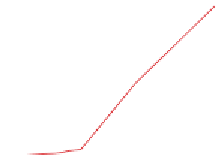Biomedical Engineering Reference
In-Depth Information
100
80
60
40
20
0
0
2
4
6
8
10
12
Time (d)
Figure 3.2. Dhc concentration relative to total Eubacteria in the SDC-9
TM
consortium during
growth in a 750-L reactor. Both Dhc and eubacteria were quantified by using qPCR.
of corrinoid co-factors that are necessary for dehaologenation by
Dhc
strains (Maym ´ -Gatell
et al.,
1997
). Genome sequencing of
D. ethenogenes
strain 195 (Seshadri et al.,
2005
) has revealed
that this strain does not have all the genes necessary for
de novo
corrinoid synthesis, but it does
contain several genes for corrinoid salvage, and He and colleagues (
2007
) demonstrated that the
addition of vitamin B12 allowed for increased growth of
Dhc
.
Analysis of growth parameters from five culture batches (550-L and 3,200-L) has shown
that the average
Dhc
specific growth rate for the SDC-9
TM
culture under the conditions
described here was 0.036 h
1
with a range of 0.027-0.043 h
1
.
Dhc
doubling time averaged
19.3
2.7 h (Vainberg et al.,
2009
). The described protocol has produced similar results with all
three cultures tested (SDC-9
TM
, PJKS
TM
, and Hawaii-05), and in each case the final
Dhc
concentration in the resulting culture is
>
10
11
Dhc
/L (Table
3.2
).
Few studies have reported large-scale production of bioaugmentation cultures. Ellis et al.
(
2000
) reported relatively large-scale production of
Dhc
for bioaugmentation, but the study
was performed before the widespread use of qPCR methods for specific monitoring of
Dhc
.
In that study, batch culturing on lactate and TCE was used to produce about 180 L of the
Pinellas culture (Harkness et al.,
1999
). The resulting culture contained about 2
10
8
total
bacteria/mL, a relatively low abundance of
Dhc
, and about 35 g DWT of cells were produced in
the culture. The culture had a doubling time of 30-40 h under optimum laboratory conditions.
Likewise, Lendvay and colleagues (
2003
) reported producing 200 L of a
Dhc
-containing culture
for field application at a Michigan site. The culture was grown in glass vessels on lactate and
PCE, and it contained 1.1
10
9
Dhc/
L.
The results presented herein demonstrate that large cultures of
Dhc
can be produced and
that high
Dhc
cell densities can be achieved in these cultures. Production of such cultures
creates the potential for treating even large contaminated sites by using bioaugmentation.
Assuming that 10
7
Dhc
/L of contaminated groundwater are needed to obtain effective and
timely remediation (Lu et al.,
2006
), 3,200 L of culture with 10
11
Dhc
/L could potentially
support remediation of 3.2
10
11
total bacteria/L and 1
10
7
L of groundwater, even without further
in situ
growth of
the organisms. This equates to a site of about 5.3 acres (2.1 ha) with a 10 ft (3 m) thick plume and
soil porosity of 25%.




































Search WWH ::

Custom Search